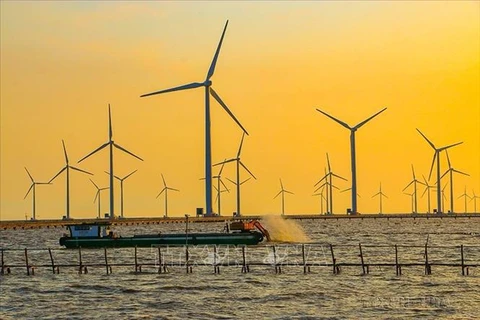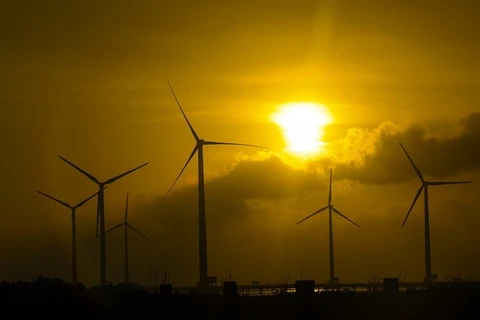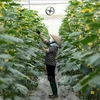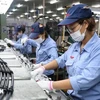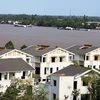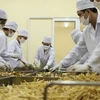Hanoi (VNS/VNA) - Renewable energy companies have recorded declining earnings results, partly due to burdens on corporate bond payment.
Xuan Thien Group is one of the major investors in the energy sector, with two clusters of solar power projects in Ninh Thuan and Dak Lak. In addition to solar power, this group also invests in hydropower, with 20 projects with a total capacity of 400MW developed to date.
According to Nguyen Van Thien, Chairman of the Xuan Thien Group, the group has more than 80 member companies in the country and abroad, with a total charter capital of more than 100 trillion VND, specialising in investing in energy production, high-tech agriculture, construction materials, banking and finance and a number of other service industries. Currently, the group's member companies own many power plants and produce construction materials, with annual revenue of 20 trillion VND.
In Dak Lak, the Xuan Thien Group invested in Xuan Thien Ea Sup solar power plant cluster, with a total investment of more than 50 trillion VND, design capacity of 2,000 MWac (equivalent to 2,800 MWp). Phase 1 of this project includes four factories: Ea Sup 1, Ea Sup 2, Ea Sup 3 and Ea Sup 5, with a total investment capital of 16.5 trillion VND, completed in 2020. Phase 2 includes 10 factories. The factories are under construction, with total investment capital of 33.5 trillion VND.
This project cluster is built on a total area of about 4,180 hectares of land and is considered one of the solar power projects with the largest capacity in Southeast Asia.
Recently, a number of companies under the Xuan Thien Group have announced financial information according to regulations on private offering and trading of corporate bonds. In particular, Ea Sup 1 Joint Stock Company showed a decrease in profits and an increase in the debt to equity ratio.
In 2021, Ea Sup 1 profit after tax reached 42.6 billion VND. In 2022, it only recorded a profit of 10.6 billion VND, down 75.1% compared to the previous year. In the first half of 2023, the company reported profit after tax of 15.5 billion VND, down 27.9% over the same period last year.
Ea Sup 1's 2023 semi-annual financial report showed that the company's equity at the end of June 2023 was 823.8 billion VND, a slight increase compared to 819.2 billion VND in the same period last year. However, the debt to equity ratio also increased from 1.91 times to 2.25 times, corresponding to liabilities of more than 1.85 trillion VND.
Ea Sup 3 Joint Stock Company reported a profit of 31.4 billion VND in 2021, but in 2022 it lost nearly 3 billion VND. In the first half of this year, it lost 7.5 billion VND. As of June 30, 2023, Ea Sup 3's equity reached 5.55 trillion VND, the debt to equity ratio was 0.35 times, equivalent to a liability of more than 1.9 trillion VND.
Similarly, Ea Sup 5 Joint Stock Company recorded an after-tax loss of 24.8 trillion VND in the first half of this year, while in the same period last year, it recorded an after-tax profit of 33.5 billion VND. As of June 30, 2023, the company's equity reached 1.07 trillion VND, the debt to equity ratio was 3.14 times, corresponding to the amount of debt payable of about 3.35 trillion VND.
In 2021, the company's profit after tax was 551.2 million VND, a sharp decrease compared to the figure of 33.9 billion VND recorded in 2020. As of December 31, 2021, the company had 3.4 billion VND in liabilities, the size of equity was 1.09 trillion VND, equivalent to a debt-to-equity ratio of 3.15 times, a sharp increase compared to 2.19 times at the end of 2020.
Like many other businesses, the Xuan Thien Group has mobilised large capital through the bond channel to invest in solar power projects.
According to the Hanoi Stock Exchange (HNX), in August 2020, Ea Sup 1 issued 11 lots of bonds with terms ranging from 2 years to 12 years, with a total value of 1.63 trillion VND.
Also in August 2020, Ea Sup 3 issued 11 lots of bonds with terms ranging from 2 years to 12 years, with a total value of 1.63 trillion VND.
Ea Sup 5 issued 11 lots of bonds in June 2020, with a total value of 2.39 trillion VND.
Ia Pet Dak Doa Wind Power Plant Number One Joint Stock Company (Ia Pet Dak Doa WPP No1) and Ia Pet Dak Doa Wind Power Number Two Joint Stock Company (Ia Pet Dak Doa WPP No2), respectively, are the investors of the Ia Pet Dak Doa 1 Wind Power Plant and Ia Pet Dak Doa 2 Wind Power Plant. These are two projects whose planning was approved in June 2020 and are the two largest wind power plants built in Gia Lai province.
According to the latest financial situation announcement of Ia Pet Dak Doa WPP No1, the company's equity as of June 30, 2023 reached 518.3 billion VND, down 18.4% over the same period last year. Liabilities were estimated at 3.3 trillion VND, 6.45 times higher than equity. Outstanding bond debt was 416.7 billion VND, down 10% over the same period last year.
In the first half of 2023, the company reported a loss of 71 billion VND, a sharp decrease compared to the loss of 160.4 billion VND recorded in the same period last year. However, this result was down sharply compared to the profit of 7 billion VND in 2021.
The situation at Ia Pet Dak Doa WPP No2 is similar. The company reported a loss of 75 billion VND in the first half of this year, a loss of 154.4 billion VND in the same period last year. At the end of the second quarter of 2023, the company's equity was 466 billion VND, down 20.7% over the same period last year. The company had 3.26 trillion VND in liabilities, 6.99 times more than equity.
In the first half of this year, outstanding bond debt of Ia Pet Dak Doa WPP No2 decreased from 448 billion VND to 403.2 billion VND. However, due to losses and decreased equity, the company's outstanding debt to equity ratio increased from 0.76 times at the end of the second quarter of last year to 0.86 times at the end of the second quarter of this year.
According to ACBS Securities Company, the poor business results of renewable energy businesses stem from many reasons, including businesses using financial leverage by mobilising large amounts of capital through bond issuance. Many businesses have a debt-to-equity ratio of more than four times. In the context of high interest rates, businesses have to use many resources to pay bond interest./.
Xuan Thien Group is one of the major investors in the energy sector, with two clusters of solar power projects in Ninh Thuan and Dak Lak. In addition to solar power, this group also invests in hydropower, with 20 projects with a total capacity of 400MW developed to date.
According to Nguyen Van Thien, Chairman of the Xuan Thien Group, the group has more than 80 member companies in the country and abroad, with a total charter capital of more than 100 trillion VND, specialising in investing in energy production, high-tech agriculture, construction materials, banking and finance and a number of other service industries. Currently, the group's member companies own many power plants and produce construction materials, with annual revenue of 20 trillion VND.
In Dak Lak, the Xuan Thien Group invested in Xuan Thien Ea Sup solar power plant cluster, with a total investment of more than 50 trillion VND, design capacity of 2,000 MWac (equivalent to 2,800 MWp). Phase 1 of this project includes four factories: Ea Sup 1, Ea Sup 2, Ea Sup 3 and Ea Sup 5, with a total investment capital of 16.5 trillion VND, completed in 2020. Phase 2 includes 10 factories. The factories are under construction, with total investment capital of 33.5 trillion VND.
This project cluster is built on a total area of about 4,180 hectares of land and is considered one of the solar power projects with the largest capacity in Southeast Asia.
Recently, a number of companies under the Xuan Thien Group have announced financial information according to regulations on private offering and trading of corporate bonds. In particular, Ea Sup 1 Joint Stock Company showed a decrease in profits and an increase in the debt to equity ratio.
In 2021, Ea Sup 1 profit after tax reached 42.6 billion VND. In 2022, it only recorded a profit of 10.6 billion VND, down 75.1% compared to the previous year. In the first half of 2023, the company reported profit after tax of 15.5 billion VND, down 27.9% over the same period last year.
Ea Sup 1's 2023 semi-annual financial report showed that the company's equity at the end of June 2023 was 823.8 billion VND, a slight increase compared to 819.2 billion VND in the same period last year. However, the debt to equity ratio also increased from 1.91 times to 2.25 times, corresponding to liabilities of more than 1.85 trillion VND.
Ea Sup 3 Joint Stock Company reported a profit of 31.4 billion VND in 2021, but in 2022 it lost nearly 3 billion VND. In the first half of this year, it lost 7.5 billion VND. As of June 30, 2023, Ea Sup 3's equity reached 5.55 trillion VND, the debt to equity ratio was 0.35 times, equivalent to a liability of more than 1.9 trillion VND.
Similarly, Ea Sup 5 Joint Stock Company recorded an after-tax loss of 24.8 trillion VND in the first half of this year, while in the same period last year, it recorded an after-tax profit of 33.5 billion VND. As of June 30, 2023, the company's equity reached 1.07 trillion VND, the debt to equity ratio was 3.14 times, corresponding to the amount of debt payable of about 3.35 trillion VND.
In 2021, the company's profit after tax was 551.2 million VND, a sharp decrease compared to the figure of 33.9 billion VND recorded in 2020. As of December 31, 2021, the company had 3.4 billion VND in liabilities, the size of equity was 1.09 trillion VND, equivalent to a debt-to-equity ratio of 3.15 times, a sharp increase compared to 2.19 times at the end of 2020.
Like many other businesses, the Xuan Thien Group has mobilised large capital through the bond channel to invest in solar power projects.
According to the Hanoi Stock Exchange (HNX), in August 2020, Ea Sup 1 issued 11 lots of bonds with terms ranging from 2 years to 12 years, with a total value of 1.63 trillion VND.
Also in August 2020, Ea Sup 3 issued 11 lots of bonds with terms ranging from 2 years to 12 years, with a total value of 1.63 trillion VND.
Ea Sup 5 issued 11 lots of bonds in June 2020, with a total value of 2.39 trillion VND.
Ia Pet Dak Doa Wind Power Plant Number One Joint Stock Company (Ia Pet Dak Doa WPP No1) and Ia Pet Dak Doa Wind Power Number Two Joint Stock Company (Ia Pet Dak Doa WPP No2), respectively, are the investors of the Ia Pet Dak Doa 1 Wind Power Plant and Ia Pet Dak Doa 2 Wind Power Plant. These are two projects whose planning was approved in June 2020 and are the two largest wind power plants built in Gia Lai province.
According to the latest financial situation announcement of Ia Pet Dak Doa WPP No1, the company's equity as of June 30, 2023 reached 518.3 billion VND, down 18.4% over the same period last year. Liabilities were estimated at 3.3 trillion VND, 6.45 times higher than equity. Outstanding bond debt was 416.7 billion VND, down 10% over the same period last year.
In the first half of 2023, the company reported a loss of 71 billion VND, a sharp decrease compared to the loss of 160.4 billion VND recorded in the same period last year. However, this result was down sharply compared to the profit of 7 billion VND in 2021.
The situation at Ia Pet Dak Doa WPP No2 is similar. The company reported a loss of 75 billion VND in the first half of this year, a loss of 154.4 billion VND in the same period last year. At the end of the second quarter of 2023, the company's equity was 466 billion VND, down 20.7% over the same period last year. The company had 3.26 trillion VND in liabilities, 6.99 times more than equity.
In the first half of this year, outstanding bond debt of Ia Pet Dak Doa WPP No2 decreased from 448 billion VND to 403.2 billion VND. However, due to losses and decreased equity, the company's outstanding debt to equity ratio increased from 0.76 times at the end of the second quarter of last year to 0.86 times at the end of the second quarter of this year.
According to ACBS Securities Company, the poor business results of renewable energy businesses stem from many reasons, including businesses using financial leverage by mobilising large amounts of capital through bond issuance. Many businesses have a debt-to-equity ratio of more than four times. In the context of high interest rates, businesses have to use many resources to pay bond interest./.
VNA

